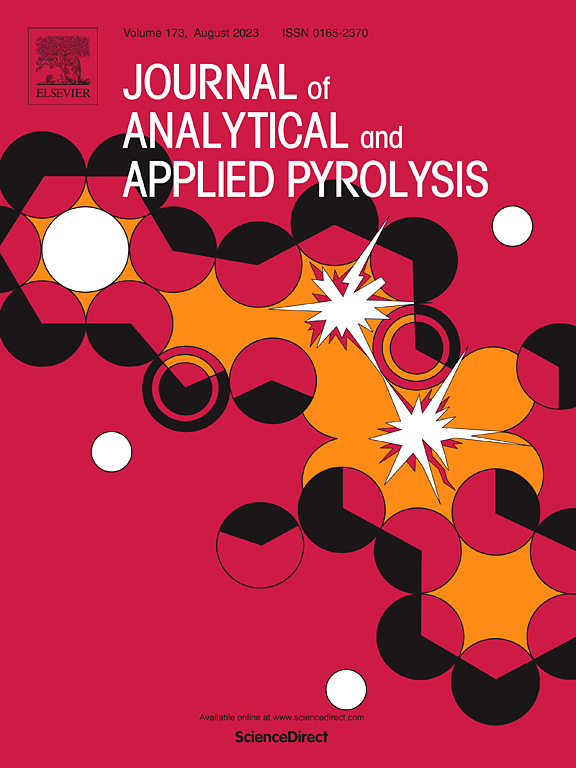Pyrolysis of Posidonia oceanica fibrous spheres: A comparative evaluation of conventional and microwave-assisted pyrolysis
IF 6.2
2区 化学
Q1 CHEMISTRY, ANALYTICAL
引用次数: 0
Abstract
Posidonia oceanica debris naturally accumulates on the coastline, negatively affecting the pleasantness of the beaches, whilst it could be advantageously exploited as a source of novel biofuels and bioproducts. In this work, grinded Posidonia oceanica fibrous spheres have been subjected to thermal pyrolysis, comparing conventional and microwave technologies, working under mild similar conditions, aimed at the integrated production of biochar, bio-oil and syngas. The microwave heating favored the cracking reactions, thus promoting the aromatization path, even more so by including a dephlegmator unit. On the other hand, conventional pyrolysis system reduces such degradation reactions, as demonstrated by the chemical composition of the corresponding bio-oil, which includes more aliphatic compounds. Remarkably, the use of the same biochar as both a microwave absorber and a reducing agent was effective for improving the selective syngas production (63 wt%), mainly composed of H2 and CO (46 and 53 vol%, respectively). The production of higher quality syngas with microwave technology is due to the occurrence of gasification reactions, through the formation of local hot spots. LCA data processing was specifically considered and developed, showing that on the laboratory scale the environmental impact of both technologies is similar, whereas on larger scale microwave-assisted pyrolysis still presents some drawbacks, mainly those associated with energy supply/management. In this context, some specific solutions were provided for making microwave-assisted pyrolysis more competitive with the conventional one, already in the next future, which is a desirable aspect to promote the intensification development of this technology.
海洋波西多尼亚纤维球的热解:常规和微波辅助热解的比较评价
海洋波西多尼亚的碎片自然地积聚在海岸线上,对海滩的宜人环境产生了负面影响,同时它可以作为新型生物燃料和生物产品的有利来源加以利用。在温和的相似条件下,对海洋波西多尼亚纤维球进行热裂解,对比常规和微波技术,旨在实现生物炭、生物油和合成气的一体化生产。微波加热有利于裂解反应,从而促进芳构化路径,甚至更多的是包括一个除痰器单元。另一方面,传统的热解系统减少了这种降解反应,从相应生物油的化学组成可以看出,生物油中含有更多的脂肪族化合物。值得注意的是,使用相同的生物炭作为微波吸收剂和还原剂可以有效地提高选择性合成气的产量(63 wt%),主要由H2和CO组成(分别为46和53 vol%)。用微波技术生产高质量合成气是由于气化反应的发生,通过局部热点的形成。对LCA数据处理进行了专门的考虑和开发,结果表明,在实验室规模上,两种技术对环境的影响是相似的,而在更大规模上,微波辅助热解仍然存在一些缺点,主要是与能源供应/管理相关的缺点。在此背景下,提出了一些具体的解决方案,以使微波辅助热解在未来的发展中更具竞争力,这是促进微波辅助热解技术集约化发展的一个理想方面。
本文章由计算机程序翻译,如有差异,请以英文原文为准。
求助全文
约1分钟内获得全文
求助全文
来源期刊
CiteScore
9.10
自引率
11.70%
发文量
340
审稿时长
44 days
期刊介绍:
The Journal of Analytical and Applied Pyrolysis (JAAP) is devoted to the publication of papers dealing with innovative applications of pyrolysis processes, the characterization of products related to pyrolysis reactions, and investigations of reaction mechanism. To be considered by JAAP, a manuscript should present significant progress in these topics. The novelty must be satisfactorily argued in the cover letter. A manuscript with a cover letter to the editor not addressing the novelty is likely to be rejected without review.

 求助内容:
求助内容: 应助结果提醒方式:
应助结果提醒方式:


